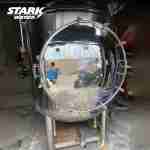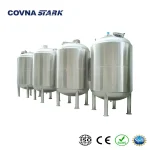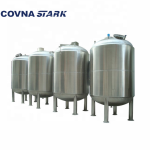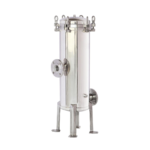In industrial water treatment, no single tank can handle everything. Effective systems require a combination of filtration units to remove suspended solids and contaminants—and storage tanks to buffer flow, equalize supply, and support downstream processes like RO, softening, or disinfection.
Whether you're designing a pre-treatment line for a reverse osmosis system or upgrading a wastewater reuse loop, integrating filtration and storage properly is the key to long-term efficiency, minimal downtime, and scalable operation. This article outlines how to select and configure filtration tanks and water storage units into one smart, process-ready system.
Understanding the Role of Storage vs. Filtration Tanks
Water tanks in industrial treatment systems serve very different purposes depending on their role. Misunderstanding these roles often leads to inefficient designs, equipment damage, or unstable water supply.
Filtration Tanks
Filtration tanks are typically used to hold media (such as sand, carbon, or resin) or house filter elements like cartridges or bags. Their primary function is to remove suspended solids, organics, or chemical contaminants from incoming water. These tanks are pressurized or flow-through systems that operate continuously and require careful sizing based on flow rate and contaminant load.
Storage Tanks
In contrast, storage tanks are used to store treated or raw water temporarily, buffer flow, or provide surge capacity. They’re essential in systems with variable flow rates, such as RO plants, where steady feed water improves membrane performance. Storage tanks can also isolate different stages of treatment or act as collection points in batch operations.
Combining these two tank types into a well-integrated system ensures smoother operation, reduces pump cycling, and allows for maintenance without halting the entire treatment process.
How to Integrate Filtration and Storage in One System
A well-integrated water treatment system uses filtration and storage tanks in tandem—sequenced and sized to match process demand, chemical requirements, and operational rhythm. Integration goes beyond simply connecting tanks via pipes. It requires thoughtful design of flow paths, level control, and accessibility for maintenance and inspection.
Typical Integration Strategies:
- Pre-Filtration → Storage → Final Filtration: Ideal for systems with intermittent water supply. Store water after sand or multimedia filtration, then feed a second polishing filter (e.g., cartridge or activated carbon) before use or RO feed.
- Filtration → Direct Use + Bypass to Storage: In high-throughput operations, filtered water is split—some sent directly to process, and excess stored for peak-hour usage or system balancing.
- Dual-Tank Loops: Used in CIP, rinse, or reclaim systems where one tank stores clean water and the other collects backflow. Each tank may be connected to filters or strainers at entry/exit points.
To integrate effectively, ensure tanks are flow-balanced, drainable, and accessible. Use level sensors and control valves to prevent overflows and dry-run pump conditions. Layout design should also support easy filter cartridge or bag replacement without halting stored water flow.
Key Design Considerations: Volume, Flow, and Contamination Control
Successfully integrating storage and filtration tanks isn’t just about layout—it requires aligning tank capacity, filtration rate, and contamination risk to your specific process needs. Misalignment in any one of these areas can create bottlenecks, hygiene issues, or equipment damage.
1. Volume Matching
The storage tank must be sized to hold enough water for peak usage while allowing time for filtration cycles and maintenance. Consider your system’s flow demand (in m³/h) and calculate minimum and emergency buffer volumes accordingly.
2. Flow Rate Synchronization
Filtration units must match the inflow and outflow capacity of storage tanks. For example, a cartridge filter system rated at 5 m³/h cannot support a process drawing 10 m³/h from the storage tank. Include bypass loops or secondary filters if flow imbalance is expected.
3. Contamination Control
Stored water is prone to microbial growth, sediment settling, or cross-contamination—especially in open-top or poorly ventilated tanks. Use closed, food-grade stainless steel tanks with sloped bottoms, manholes for inspection, and sterile breather valves for hygiene-sensitive systems.
Designing for these parameters ensures your integrated system remains stable, safe, and compliant with regulatory or operational standards.
Common Layout Configurations in Industrial Facilities
Integrating storage and filtration tanks efficiently depends on your industry, water source, and processing sequence. Below are common layout patterns used across industrial plants to maximize flow efficiency, minimize contamination risk, and simplify maintenance.
1. RO Pre-Treatment System
Layout: Raw Water Tank → Multi-media Filter → Cartridge Filter → RO Feed Tank
Purpose: The raw water tank buffers variable supply. Filtration tanks remove suspended solids and protect the RO membrane. The RO feed tank ensures stable supply and acts as a surge buffer.
2. CIP (Clean-in-Place) System
Layout: Hot Water Storage Tank → Inline Cartridge Filter → Return Tank
Purpose: The system recirculates hot water for sanitization. The inline filter prevents solids from re-entering the clean loop. Return tanks are used for recovery and reheat operations.
3. Wastewater Reuse System
Layout: Equalization Tank → Bag Filter → Holding Tank → Reuse Point
Purpose: Equalization ensures consistent quality. Bag filters remove bulk solids. The holding tank provides capacity for treated water storage prior to reuse in utilities or irrigation.
Each layout prioritizes stability, access, and hygiene. By selecting appropriately sized tanks, filter types, and interconnecting piping, you can streamline operations while minimizing cost and downtime.
Conclusion: Design a Smarter Tank System for Long-Term Efficiency
Combining storage and filtration tanks in a thoughtful, process-aligned design is essential to building a stable, efficient, and scalable water treatment system. When properly integrated, these tanks don’t just store and filter—they synchronize flow, reduce maintenance, and enhance overall system performance.
At STARK, we support industrial clients with modular stainless steel and FRP tanks, custom filtration units, and complete layout recommendations. Whether you're designing a RO pre-treatment line, a CIP system, or a wastewater reuse loop, we help ensure your tanks and filters work together, not against each other.
Looking to design or upgrade your integrated tank system?
Contact our technical team for expert support, layout drawings, and equipment recommendations tailored to your process.





